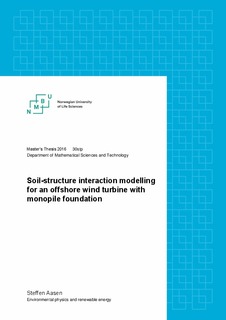| dc.description.abstract | The last decade, there has been an increased use of offshore sites for harvesting wind energy. With a
more complex environment than onshore, leading to higher energy prices, cost reductions becomes
important for the industry.
With this in mind, the REDWIN research project has been initiated, supported by the Norwegian
Reseach Counsil ENERGIX program. The goal of the program is to reduce cost in offshore wind by
integrated structural and geothecnical design. This thesis contributes to this project by investigating the
influence on fatigue damage and maximum moments on an OWT, for different soil-structure interaction
models. The models has been applied on the NREL 5MW monopile wind turbine.
To investigate the effect of soil damping, three different soil-structure interaction models has been
investigated. The reference model has a stiffness matrix at the mudline, according to that developed by
Passon (2006) for the Offshore Code Comparison Collaboration 3 (Jonkman and Musial, 2010). The
second model uses the same stiffness matrix, with a rotational dashpot damper, to account for soil
damping. The third model has been developed by NGI (Norwegian Geotechnical Institute) for the
REDWIND project, and is a kinematic hardening soil model.
The accumulated fatigue damage on the OWT structure is reduced by 11% at the mudline, when
applying a rotational dashpot damper to account for soil damping. At the tower root, the reduction of
fatigue damage is 16%. With the kinematic hardening model, the reduction of fatigue damage is 3% at
the mudline, and 7% at the tower root. Both models are seen relative to the reference model, with no
soil damping. The results show that damping has a significant effect on fatigue damage for a bottom
fixed offshore wind turbine. The difference between the models, are due to different damping
characteristics, and implies that a dashpot damper tend to over-estimate soil damping. | nb_NO |

